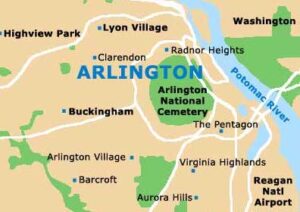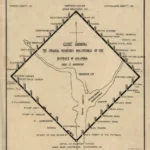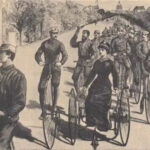 Here is an organized tour of some of the historical sites located in Arlington County, Virginia. It has been arranged so one may travel by automobile and make reference to the itinerary given below. A person has the option of completing the whole tour or taking any portion of the tour depending upon his time and circumstances. In addition, one may start the tour from any given place on the itinerary and travel in either direction by following the guide map. However, mileage and orientation are from the given starting point.
Here is an organized tour of some of the historical sites located in Arlington County, Virginia. It has been arranged so one may travel by automobile and make reference to the itinerary given below. A person has the option of completing the whole tour or taking any portion of the tour depending upon his time and circumstances. In addition, one may start the tour from any given place on the itinerary and travel in either direction by following the guide map. However, mileage and orientation are from the given starting point.
The complete tour by automobile should take about four hours and cover approximately 30 miles of paved roads throughout the county. This tour is not designed to be a comprehensive journey or to include all historical sites, but to serve as a general introduction to the many cultural and historical aspects of Arlington County. For the original story click here.
ITINERARY/Mileage Remarks
0.0 Start tour at Lubber Run Recreation Center at North George Mason Drive and North Park Street. Site of the old Henderson House and part of the original John Colville land grant of 1731.
Turn left on North George Mason Drive and follow it to Carlyn Springs Road.
0.1 Cross over Lubber Run, a branch of Four Mile Run. Left is Lubber Run Park, first park to be accepted by the County Board on October 9, 1942, and the start of the Arlington County Park System.
0.2 Turn right on North Carlyn Springs Road and follow this road to 3rd Street, South, in the Glencarlyn area.
1.0 Left at 5512 North Carlyn Springs Road is the Mary Carlin House, a log cabin built around 1800 which has had several modern additions. Cross over Four Mile Run, the major drainage system within Arlington County – This was also one of the rights-of-way for the Washington and Old Dominion Railroad. Turn left onto 3rd Street, South. You are now in the Glencarlyn area, the first planned community in Arlington County, established in 1887.
1.5 Intersection with South Kensington Street. Right is the Glencarlyn Branch Library and left was General Samuel S. Burdett’s home, a two story, white, frame house. General Burdett was one of the founders of the Glencarlyn planned subdivision.
1.6 Across the street from the Glencarlyn Library is the site of John Ball’s log house located at 5620 3rd Street, South. In 1742 John Ball took out a patent for 166 acres, beginning on the south· side of Four Mile Run at its confluence with the Long Branch- The Ball House is shown on Col. John Colville’s survey of 1755. Logs of the original pioneer home are within the walls of the present residence. There is no visible sign of antiquity, for in 1915 a clapboard cocoon encased the only remaining portion of the log house, to match the two story wing which had been added about 1885. This is probably the only house of pre-Revolutionary times remaining in Arlington County. Continue on to South Harrison Street.
1.8 Right on South Harrison Street.
1.85 Left on a one lane paved road leading down to Glencarlyn Park.
2.1 Stop at parking lot just past shelter on left. Follow Four Mile Run on foot downstream for about 30 feet and you will find a marker at the junction with Upper Long Branch. This marker indicates the location of an oak tree used by George Washington to determine one of the points showing the western limits of his 1200 acre Washington Forest tract- A section of this oak is on exhibit in the Glencarlyn Library. Return to the parking lot and follow the paved road parallel to Four Mile Run and back to South Harrison Street.
2.4 Left on South Harrison Street and right on 4th Street, South. Follow this road to Carlyn Springs Road.
2.7 Intersection with South Kensington Street. Right is the old Glencarlyn Cemetery and Glencarlyn Hall, now known as the Glencarlyn Recreation Center.
2.9 Left on South Carlyn Springs Road. You will pass Northern Virginia Doctors Hospital and cross over Upper Long Branch.
3.8 Left on Columbia Pike. Go one block to South Jefferson Street-
3.9 Right on South Jefferson Street. Go 300 feet to boundary stone.
4.0 Location of jurisdiction boundary stone No, 6 in median strip. This marks the boundary between Arlington and Fairfax Counties. Return to Columbia Pike.
4.1 Right on Columbia Pike and continue to the Barcroft area.
4.8 After crossing Four Mile Run, here the site of the Arlington Mill, turn right on Four Mile Run Drive- Follow this road to Walter Reed Drive. Note abandoned right-of-way for the Washington and Old Dominion Railroad.
5.8 Left on Walter Reed Drive, and continue to South Glebe Road.
6.0 Right is site of the Civil War Fort Barnard, now a playground.
6.5 Right on South Glebe Road. Continue on this road toward Jefferson Davis Highway. You will have passed through the Green Valley area.
7.2 Go under the Shirley Highway overpass.
7.4 Right is Four Mile Run which parallels South Glebe Road.
8.3 Intersection with South Arlington Ridge Road. Arlandria is to your right. Continue to the Jefferson Davis Highway (U.S. #1).
9.0 Left on U.S. # 1 and continue to the National Airport overpass.
9.4 Right onto the National Airport overpass.
9.5 Follow road and turn right to parking lot adjacent to the FAA Radar Dome. Located nearby is the site of Abingdon, birthplace of Nellie Custis, the adopted daughter of General George Washington. Original land grant 1669. Purchased by John Parke Custis in 1778 from the Alexanders for whom Alexandria, Virginia was named. Destroyed by fire in 1930.
9.5 Return to Jefferson Davis Highway (U.S. # 1). Crystal City development lies to your right. The area north of here was once known as Waterloo.
10.4 Left on 23rd Street, South. Continue to South Arlington Ridge Road.
11-6 Right on South Arlington Ridge Road to 1805 where the Hume School Historical Museum is located. This is the home of the Arlington Historical Society and only museum on the local history of Arlington County. It is open on Sunday afternoons from 2 to 4p.m. and by special arrangement ( free of charge). Hume School was built in 1895 and is the oldest school building remaining in Arlington County.
11. 7 Continue on South Arlington Ridge Road for about 300 feet until you reach the leJt turnoff to Shirley Highway. Cross over Shirley Highway and bear left under the overpass onto Washington Boulevard. Follow Washington Boulevard to Arlington Boulevard and turn right.
13.2 Right on Arlington Boulevard toward Washington, D.C. Right is Fort Myer, site of Fort Whipple during the Civil War and part of the Arlington Line- After the war, Fort Whipple was maintained as a permanent military post. In 1880 the name was changed to Fort Myer. This property was part of the Arlington Estate confiscated by the U.S. Government from the Robert E. Lee family in 1861.
14.0 Left on North Court House Road. Continue to the Arlington County Court House. This was the location of Fort Woodbury, a lunette in the Arlington Line constructed in August, 1861. The Court House was moved to this location in 1898- Stop and look at memorials on 15th Street, north side of Court House building.
14.2 Right on 16th Street, North, and continue to the Rosslyn area.
14.9 Right on Wilson Boulevard to North Lynn Street in Rosslyn. Georgetown was established in 1753 and Awbury ran a ferry across the Potomac from the present site of Rosslyn. In 1860 William Ross operated a large farm here which he called Rosslyn. Later a development was platted here by the same name.
15.4 Left at Rosslyn circle onto Lee Highway and continue to North Oak Street. Key Bridge is to your right.
15.7 Right at North Oak Street and one block later, left on 22nd Street, North. Site of Fort Bennett, a Civil War fortification, destroyed during the construction of the Fort Bennett Apartments-
16.0 Left on North Queen Street and one block later right on 21st Road, North.
16.1 Left on North Rolfe Street and one block later right on 21st Road, North. Continue to North Taft Street.
16.2 Intersection with North Taft Street. On your right is the Dawson-Bailey House. This house is probably the second oldest structure in Arlington County. The land was first patented in 1696; a house at this site is shown on a survey of 1785. Thomas Dawson enlarged the present house by adding the east end in 1859. He left the place to his daughter, Bessie Lola, who married W. C. Bailey. She lived here for 94 years and died in 1955. It is now part of Arlington County’s Dawson Terrace Playground facilities.
16.2 Left on North Taft Street and one block later, right on 21st Street, North.
16.4 Left on North Court House Road and right on Lee Highway (U.S. #29).
16.8 Right is the site of Fort Strong, destroyed when the Fort Strong Apartment complex was constructed near the Wayne Street intersection with Lee Highway.
17-2 Lee Highway crosses over Spout Run, now underground at this location.
17.5 You are now passing through the community known as Cherrydale. The name was derived from the large cherry orchard which Dorsey Donaldson had planted on his farm in this area after the Civil War.
17.8 Right on Military Road. This road was constructed in the fall of 1861 to connect Forts Ethan Allen and Marcy, which guarded the Virginia approaches to the Chain Bridge, with Fort Strong which formed the right of the Arlington line of forts built by Union forcesas part of the defenses of Washington.
18.6 Right on Marcey Road which is named after the James Marcey, Sr., family. They were County residents in the early 1800’s and owned land on both sides of Military Road. The general area became known as Marceytown and the road which still bears the Marcey name was that which led to their home place. Much of the area along Marcey Road has been acquired for a park by the Northern Virginia Regional Park Authority. An old Indian village site lies at the end of Marcey Road. Return to Military Road, and turn right, then follow the road to North Glebe Road.
20.8 Military Road crosses over Gulf Run, a tributary which flows into the Potomac River. This is another park in the Arlington County system.
21.2 Left on North Glebe Road. Left lies a portion of Fort Ethan Allen in the James Monroe School grounds. This bastioned earthwork was built in September, 1861, to command all the approaches to Chain Bridge south of Pimmit Run.
21.3 Left is the Glebe Recreation Center.
21.5 Right is Walker’s Chapel and cemetery. A Methodist Church was first erected here in 1871 and named after the Walker family who donated land for this purpose. In 1903, a new church was built on the site with additions in 1952 and 1954. Left on North Glebe Road and continue to Little Falls Road.
21.8 Right on Little Falls Road. This road, leading from Falls Church to Chain Bridge, was one of the earliest roads in Arlington.
22.2 Right lies Reserve Hill which is the present headquarters of the Knights of Columbus. The stone house at 5115 Little Falls Road was built in 1904. The white columns show a Southern influence with the stone work styled along the lines of a European castle. The stone water tower at the rear of the house is an exact replica of a gate tower in the Nurnberg, Germany, city wall- Follow Little Falls Road to its junction with Williamsburg Boulevard.
23.4 Near the junction of Little Falls Road and Williamsburg Boulevard lies Minor’s Hill, the highest elevation in the County.
23.4 Left on Williamsburg Boulevard and follow this road until you reach North Arizona Street.
24.6 Left on North Arizona Street and travel about 100 feet. To your right lies a small tract containing a boundary stone placed at the original west corner of the Ten Mile Square by surveyor Andrew Ellicott in 1791. This location marks the boundaries of the City of Falls Church and the Counties of Arlington and Fairfax. Continue on Meridian Street, as it is known in Falls Church, to Lincoln Avenue.
24.8 Left on Lincoln Avenue and follow to its junction with Lee Highway- This street changes its name in Arlington County to Fairfax Drive. Right is the site of the old Falls Church Station of the Washington and Old Dominion Railroad system, now dismantled.
25.4 Left on Lee Highway to North Powhatan Street and turn right. Go two blocks.
25.5 On your right lies Maple Shade at 2230 North Powhatan Street, a two story, white frame house, built in 1851 by Captain Henry W. Febrey. This home bears within its walls hidden scars of the Hall’s Hill skirmish which occurred at the time of the “Battle of Munson Hill,” which was the only notable engagement to take place within the boundaries of Arlington County during the Civil War. Return to Lee Highway.
25.6 Right on Lee Highway to North Cameron Street. Enroute you will pass the Overlee community area.
26.8 Right on North Cameron Street between the church and the totem pole park. This is the area once known as Hall’s Hill, now High View Park. Follow North Cameron Street to 17th Street, North.
27.2 Left on 17th Street, North, cross North Glebe Road and go one block.
27.4 Left at the intersection with North Wakefield Street, is the Glebe House. The glebe was a 500-acre farm to provide for the support of both Christ Church, Alexandria and the Falls Church. The Glebe House, built in 1775, stood here. It burned in 1808 and was rebuilt in 1820, as a hunter’s lodge. The octagon wing was added about 1850.
27.4 Right on North Wakefield Street, go one block and turn right on 16th Street, North. Go one block and turn left on North Glebe Road-
27.5 Left on North Glebe Road. This road was named after the Glebe Farm and portions of the present road ran from Alexandria to Chain Bridge Road.
27.6 Right is Mount Olivet Methodist Church, established in 1854. This church site served as a hospital for the Union troops after the first Battle of Bull Run in 1861, and later was used as a commissary, guard post, and stables. The present church building was constructed in 1948. Continue on North Glebe Road.
28.2 Intersection of Wilson Boulevard and North Glebe Road. This location has been a focal point in Arlington County since about 1740. When Ball’s Tavern was established here in the early 1800’s, it was known as Ball’s Crossroads. Continue to Henderson Road.
28.7 Right on Henderson Road, named after the John B. Henderson estate, a portion of which became the Arlington Forest subdivision and Lubber Run Park.
28.9 Right on North George Mason Drive and return to the Lubber Run Recreation Center. End of Tour.


